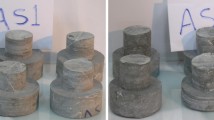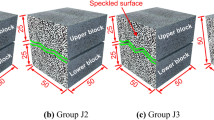Abstract
Basic friction angle is an important input parameter in many peak shear strength criteria of rock joint. Reliable estimation of joint basic friction angle is essential for accurate determination of the corresponding peak shear strength. In this study, the basic friction angles of planar joint surface of three rocks (i.e., granite, marble, and sandstone) are studied using two commonly used methods, including tilt test and direct shear test. Although the basic friction angles determined from tilt test are about 4 to 5° smaller than those determined from direct shear test, the marble is found to have the largest basic friction angle in both tilt test and direct shear test. In direct shear test, there is about 2° difference of basic friction angles determined under low and high normal stress conditions, which is mainly associated with the shearing mechanism of joint surface. Friction generally occurs under low normal stress. On the other hand, shear-off is observed when the applied normal stress is high. To obtain a reliable basic friction angle using direct shear test, the test data under low normal stresses are suggested to be used. It is also seen from the results that the shear strength of planar joint surface is negligibly influenced by the cyclic shearing when the applied normal stress is low. The data in this study replenish the test data of basic friction angle of different rock types and are useful for establishing a database for the estimation of basic friction angle in future.








Similar content being viewed by others
References
Alejano LR, González J, Muralha J (2012) Comparison of different techniques of tilt testing and basic friction angle variability assessment. Rock Mech Rock Eng 45(6):1023–1035
Alejano LR, Muralha J, Ulusay R, Li CC, Pérez-Rey I, Karakul H, Chryssanthakis P, Aydan Ö (2018) ISRM suggested method for determining the basic friction angle of planar rock surfaces by means of tilt tests. Rock Mech Rock Eng 51:3853–3859
Atapour H, Moosavi M (2014) The influence of shearing velocity on shear behavior of artificial joints. Rock Mech Rock Eng 47:1745–1761
Bahaaddini M, Hagan PC, Mitra R, Khosravi MH (2016) Experimental and numerical study of asperity degradation in the direct shear test. Eng Geol 204:41–52
Ban L, Qi C, Chen H, Yan F, Ji C (2020) A new criterion for peak shear strength of rock joints with a 3D roughness parameter. Rock Mech Rock Eng 53:1755–1775
Barton N. A relationship between joint roughness and joint shear strength. Proceedings of International Symposium on Rock Mechanics and Rock Fracture, Nancy, 1971, 1–8.
Barton N, Choubey V (1977) The shear strength of rock joints in theory and practice. Rock Mech 10(1–2):1–54
Behnia M, Nateghpour B (2020) Considerations on the laboratory measurement of the basic friction angle of planar rock surfaces/effect of testing methods and surface polishing. Geotech Geol Eng 38:2945–2956
Coulson JH. Shear strength of flat surfaces in rock. 13th Symposium on Rock Mechanics, America Society of Civil Engineering, Urbana, 1972, 77–105.
Cruden DM, Hu XQ (1988) Basic friction angles of carbonate rocks from Kananaskis county, Canada. Bull Int Assoc Eng Geol 38(1):55–59
Cui Y (2019) Effect of joint type on the shear behavior of synthetic rock. Bull Eng Geol Env 78:3395–3412
Dang W, Konietzky H, Frühwirt T (2016) Direct shear behavior of a plane joint under dynamic normal load (DNL) conditions. Eng Geol 213:133–141
González J, González-Pastoriza N, Castro U, Alejano LR, Muralha J. Considerations on the laboratory estimate of the basic friction angle of rock joints. EUROCK 2014, ISRM, Vigo, 2014, pp 199–204.
Grasselli G, Egger P (2003) Constitutive law for the shear strength of rock joints based on three-dimensional surface parameters. Int J Rock Mech Min Sci 40(1):25–40
Hencher SR, Richards LR (2015) Assessing the shear strength of rock discontinuities at laboratory and field scales. Rock Mech Rock Eng 48:883–905
Horn HM, Deere DU (1962) Frictional Characteristics of Minerals. Géotechnique 12:319–335
Hou D, Rong G, Yang J, Zhou C, Peng J, Wang X (2016) A new shear strength criterion of rock joints based on cyclic shear experiment. Eur J Environ Civ Eng 20(2):180–198
Hu W, Huang R, McSaveney M, Zhang X, Yao L, Shimamoto T (2018) Mineral changes quantify frictional heating during a large low-friction landslide. Geology 46(3):223–226
Jang HS, Jang BA (2015) New method for shear strength determination of unfilled, unweathered rock joint. Rock Mech Rock Eng 48(4):1515–1534
Jang HS, Zhang QZ, Kang SS, Jang BA (2018) Determination of the basic friction angle of rock surfaces by tilt tests. Rock Mech Rock Eng 51:989–1004
Jing L, Stephansson O, Nordlund E (1993) Study of rock joints under cyclic loading conditions. Rock Mech Rock Eng 26:215–232
Kranz RL (1983) Microcracks in rocks: A review. Tectonophysics 100(1):449–480
Krsmanovic D (1967) Initial and residual shear strength of hard rock. Geotechnique 17(2):145–160
Kulatilake PHSW, Shou G, Huang TH, Morgan RM (1995) New peak shear strength criteria for anisotropic rock joints. Int J Rock Mech Min Sci Geomech Abstr 32(7):673–697
Ladanyi B, Archambault G. Simulation of shear behavior of a jointed rock mass. 11th U.S. symposium on rock mechanics (USRMS), Berkeley, 16–19 June, 1969.
Lee SB, Chang CD (2015) Laboratory experimental study on fracture shear-activation induced by carbon dioxide injection. J Geol Soc 51(3):281–288
Lee HS, Park YJ, Cho TF, You KH (2001) Influence of asperity degradation on the mechanical behavior of rough rock joints under cyclic shear loading. Int J Rock Mech Min Sci 38:967–980
Li C, Zhang N, Ruiz J (2019) Measurement of the basic friction angle of planar rock discontinuities with three rock cores. Bull Eng Geol Env 78:847–856
Li Y, Tang CA, Li D, Wu C (2020) A new shear strength criterion of three-dimensional rock joints. Rock Mech Rock Eng 53:1477–1483
Muralha J, Pe´rez-Rey I, Alejano LR (2019) Experimental study of factors controlling tilt-test results performed on saw-cut rock joints. Geotech Test J 42:307–330
Patton FD. Multiple modes of shear failure in rock. 1st ISRM congress, Lisbon, 25 Sep-1 Oct, 1966.
Pe´rez-Rey I, Alejano LR, Gonza´lez-Pastoriza N, Gonza´lez J, Arzu´a J. Effect of time and wear on the basic friction angle of rock discontinuities. ISRM regional symposium-EUROCK 2015, 2015.
Richards LR. The shear strength of joints in weathered rock. Ph. D. Thesis. University of London, Imperial College, 1975, pp427.
Stimpson B (1981) A suggested technique for determining the basic friction angle of rock surface using core. Int J Rock Mech Min Sci Geomech Abstr 18(1):63–65
Tang ZC, Zhang QZ, Peng J (2020) Effect of thermal treatment on the basic friction angle of rock joint. Rock Mech Rock Eng 53:1973–1990
Tang ZC, Zhang ZF, Zuo CQ, Jiao YY (2021) Peak shear strength criterion for mismatched rock joints: Revisiting JRC-JMC criterion. Int J Rock Mech Min Sci 147:104894
Ulusay R, Karakul H (2016) Assessment of basic friction angles of various rock types from Turkey under dry, wet and submerged conditions and some considerations on tilt testing. Bull Eng Geol Env 75:1683–1699
Wallace GB, Slebir EJ, Anderson FA. Foundation testing for Auburn Dam. Proceedings of llth Symposium on Rock Mechanics, Berkeley, Calif., 1970, 461–498.
Xia CC, Tang ZC, Song YL (2014) New peak shear strength criterion of rock joints based on quantified surface description. Rock Mech Rock Eng 47:387–400
Yang J, Rong G, Hou D, Peng J, Zhou C (2016) Experimental study on peak shear strength criterion for rock joints. Rock Mech Rock Eng 49(3):821–835
Zhao J (1997) Joint surface matching and shear strength part B: JRC-JMC shear strength criterion. Int J Rock Mech Min Sci 34:179–185
Funding
The research work presented in this paper is in part supported by the Natural Science Foundation of China (grant no. 51609178), the Natural Science Foundation of Hubei Province (grant no. 2018CFB593), Natural Science Foundation of Anhui Province (grant no. 2008085QE221), the China Postdoctoral Science Foundation (grant nos. 2015M582273 and 2018T110800), the Open-end Research Fund of the State Key Laboratory for GeoMechanics and Deep Underground Engineering (Grant no. SKLGDUEK1709), and Key project of Higher Education Department of Anhui Province (grant no. KJ2020A0235).
Author information
Authors and Affiliations
Corresponding author
Ethics declarations
Conflict of interest
The authors declare no competing interests.
Additional information
Responsible Editor: Zeynal Abiddin Erguler
Publisher’s note
Springer Nature remains neutral with regard to jurisdictional claims in published maps and institutional affiliations.
Rights and permissions
About this article
Cite this article
Peng, J., Tang, Z., Xu, C. et al. Determination of basic friction angle of three planar rock joints. Arab J Geosci 15, 885 (2022). https://doi.org/10.1007/s12517-022-10205-3
Received:
Accepted:
Published:
DOI: https://doi.org/10.1007/s12517-022-10205-3




